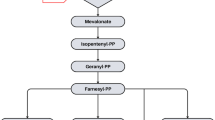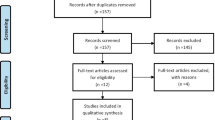Abstract
Statins lower cholesterol by inhibiting 3-hydroxy-3-methylglutaryl coenzyme A (HMG-CoA) reductase, the rate-limiting enzyme in the biosynthesis of cholesterol. However, severe adverse events, including myalgias and rhabdomyolysis, have been reported with statin treatment. Different mechanisms have been proposed to explain statin-induced myopathy, including reduction of mevalonate pathway products, induction of apoptosis, mitochondrial dysfunction, and genetic predisposition. A decrease in coenzyme Q10 (CoQ), a product of the mevalonate pathway, could contribute to statin induced myopathy. This article reviews the clinical and biochemical features of statin-induced myopathy, the inter-relationship between statins and the concentration of CoQ in plasma and tissues, and whether there is a role for supplementation with CoQ to attenuate statin-induced myopathy.

Similar content being viewed by others
References
Papers of particular interest, published recently, have been highlighted as: •• Of major importance
Murphy SA, Cannon CP, Wiviott SD, et al.: Effect of intensive lipid-lowering therapy on mortality after acute coronary syndrome (a patient-level analysis of the Aggrastat to Zocor and Pravastatin or Atorvastatin Evaluation and Infection Therapy-Thrombolysis in Myocardial Infarction 22 trials). Am J Cardiol 2007, 100:1047–1051.
Thavendiranathan P, Bagai A, Brookhart MA, Choudhry NK: Primary prevention of cardiovascular diseases with statin therapy: a meta-analysis of randomized controlled trials. Arch Intern Med 2006, 166:2307–2313.
Mukhtar RY, Reckless JP: Statin-induced myositis: a commonly encountered or rare side effect? Curr Opin Lipidol 2005, 16:640–647.
Sewright KA, Clarkson PM, Thompson PD: Statin myopathy: incidence, risk factors, and pathophysiology. Curr Atheroscler Rep 2007, 9:389–396.
Pasternak RC, Smith SC Jr, Bairey-Merz CN, et al.: ACC/AHA/NHLBI Clinical Advisory on the Use and Safety of Statins. Stroke 2002, 33:2337–2341.
Thompson PD, Clarkson PM, Rosenson RS: An assessment of statin safety by muscle experts. Am J Cardiol 2006, 97:69C–76C.
•• Siddiqi SA, Thompson PD: How do you treat patients with myalgia who take statins? Curr Atheroscler Rep 2009, 11:9–14. This review provides recommendations regarding statin-related adverse events.
Bruckert E, Hayem G, Dejager S, et al.: Mild to moderate muscular symptoms with high-dosage statin therapy in hyperlipidemic patients--the PRIMO study. Cardiovasc Drugs Ther 2005, 19:403–414.
•• Venero CV, Thompson PD: Managing statin myopathy. Endocrinol Metab Clin North Am 2009, 38:121–136. This review examines symptoms of statin-induced myalgia and suggests clinical approaches to its management.
Law M, Rudnicka AR: Statin safety: a systematic review. Am J Cardiol 2006, 97:52C–60C.
Kashani A, Phillips CO, Foody JM, et al.: Risks associated with statin therapy: a systematic overview of randomized clinical trials. Circulation 2006, 114:2788–2797.
Ginsberg HN, Elam MB, Lovato LC, et al.: Effects of combination lipid therapy in type 2 diabetes mellitus. N Engl J Med 2010, 362:1563–1574.
Crane FL, Hatefi Y, Lester RL, Widmer C: Isolation of a quinone from beef heart mitochondria. Biochim Biophys Acta 1957, 25:220–221.
Crane FL: Biochemical functions of coenzyme Q10. J Am Coll Nutr 2001, 20:591–598.
Turunen M, Olsson J, Dallner G: Metabolism and function of coenzyme Q. Biochim Biophys Acta 2004, 1660:171–199.
Tomono Y, Hasegawa J, Seki T, et al.: Pharmacokinetic study of deuterium-labelled coenzyme Q10 in man. Int J Clin Pharmacol Ther Toxicol 1986, 24:536–541.
Tomasetti M, Alleva R, Solenghi MD, Littarru GP: Distribution of antioxidants among blood components and lipoproteins: significance of lipids/CoQ10 ratio as a possible marker of increased risk for atherosclerosis. Biofactors 1999, 9:231–240.
•• Villalba JM, Parrado C, Santos-Gonzalez M, Alcain FJ: Therapeutic use of coenzyme Q(10) and coenzyme Q(10)-related compounds and formulations. Expert Opin Investig Drugs 2010, 19:535–554. This review addresses the therapeutic use of CoQ, including existing formulations and their effects on its bioavailability.
Willis RA, Folkers K, Tucker JL, et al.: Lovastatin decreases coenzyme Q levels in rats. Proc Natl Acad Sci U S A 1990, 87:8928–8930.
Folkers K, Langsjoen P, Willis R, et al.: Lovastatin decreases coenzyme Q levels in humans. Proc Natl Acad Sci U S A 1990, 87:8931–8934.
Ashton E, Windebank E, Skiba M, et al.: Why did high-dose rosuvastatin not improve cardiac remodeling in chronic heart failure? Mechanistic insights from the UNIVERSE study. Int J Cardiol 2010 (in press).
Davidson M, McKenney J, Stein E, et al.: Comparison of one-year efficacy and safety of atorvastatin versus lovastatin in primary hypercholesterolemia. Atorvastatin Study Group I. Am J Cardiol 1997, 79:1475–1481.
Ghirlanda G, Oradei A, Manto A, et al.: Evidence of plasma CoQ10-lowering effect by HMG-CoA reductase inhibitors: a double-blind, placebo-controlled study. J Clin Pharmacol 1993, 33:226–229.
Watts GF, Castelluccio C, Rice-Evans C, et al.: Plasma coenzyme Q (ubiquinone) concentrations in patients treated with simvastatin. J Clin Pathol 1993, 46:1055–1057.
Human JA, Ubbink JB, Jerling JJ, et al.: The effect of Simvastatin on the plasma antioxidant concentrations in patients with hypercholesterolaemia. Clin Chim Acta 1997, 263:67–77.
Laaksonen R, Jokelainen K, Laakso J, et al.: The effect of simvastatin treatment on natural antioxidants in low-density lipoproteins and high-energy phosphates and ubiquinone in skeletal muscle. Am J Cardiol 1996, 77:851–854.
Laaksonen R, Riihimaki A, Laitila J, et al.: Serum and muscle tissue ubiquinone levels in healthy subjects. J Lab Clin Med 1995, 125:517–521.
Mabuchi H, Nohara A, Kobayashi J, et al.: Effects of CoQ10 supplementation on plasma lipoprotein lipid, CoQ10 and liver and muscle enzyme levels in hypercholesterolemic patients treated with atorvastatin: a randomized double-blind study. Atherosclerosis 2007, 195:e182–189.
Littarru GP, Langsjoen P: Coenzyme Q10 and statins: biochemical and clinical implications. Mitochondrion 2007, 7(Suppl):S168–174.
Passi S, Stancato A, Aleo E, et al.: Statins lower plasma and lymphocyte ubiquinol/ubiquinone without affecting other antioxidants and PUFA. Biofactors 2003, 18:113–124.
Bleske BE, Willis RA, Anthony M, et al.: The effect of pravastatin and atorvastatin on coenzyme Q10. Am Heart J 2001, 142:E2.
Marcoff L, Thompson PD. The role of coenzyme Q10 in statin-associated myopathy: a systematic review. J Am Coll Cardiol 2007, 49:2231–2237.
Low P, Andersson M, Edlund C, Dallner G: Effects of mevinolin treatment on tissue dolichol and ubiquinone levels in the rat. Biochim Biophys Acta 1992, 1165:102–109.
Fukami M, Maeda N, Fukushige J, et al.: Effects of HMG-CoA reductase inhibitors on skeletal muscles of rabbits. Res Exp Med (Berl) 1993, 193:263–273.
Schaefer WH, Lawrence JW, Loughlin AF, et al.: Evaluation of ubiquinone concentration and mitochondrial function relative to cerivastatin-induced skeletal myopathy in rats. Toxicol Appl Pharmacol 2004, 194:10–23.
Laaksonen R, Jokelainen K, Sahi T, et al.: Decreases in serum ubiquinone concentrations do not result in reduced levels in muscle tissue during short-term simvastatin treatment in humans. Clin Pharmacol Ther 1995, 57:62–66.
Paiva H, Thelen KM, Van Coster R, et al.: High-dose statins and skeletal muscle metabolism in humans: a randomized, controlled trial. Clin Pharmacol Ther 2005, 78:60–68.
Schick BA, Laaksonen R, Frohlich JJ, et al.: Decreased skeletal muscle mitochondrial DNA in patients treated with high-dose simvastatin. Clin Pharmacol Ther 2007, 81:650–653.
Sirvent P, Mercier J, Lacampagne A: New insights into mechanisms of statin-associated myotoxicity. Curr Opin Pharmacol 2008, 8:333–338.
Kobayashi M, Kagawa T, Narumi K, et al.: Bicarbonate supplementation as a preventive way in statins-induced muscle damage. J Pharm Pharm Sci 2008, 11:1–8.
Golomb BA, Evans MA: Statin adverse effects : a review of the literature and evidence for a mitochondrial mechanism. Am J Cardiovasc Drugs 2008, 8:373–418.
Sacconi S, Trevisson E, Salviati L, et al.: Coenzyme Q10 is frequently reduced in muscle of patients with mitochondrial myopathy. Neuromuscul Disord 2010, 20:44–48.
Levy HB, Kohlhaas HK: Considerations for supplementing with coenzyme Q10 during statin therapy. Ann Pharmacother 2006, 40:290–294.
De Pinieux G, Chariot P, Ammi-Said M, et al.: Lipid-lowering drugs and mitochondrial function: effects of HMG-CoA reductase inhibitors on serum ubiquinone and blood lactate/pyruvate ratio. Br J Clin Pharmacol 1996, 42:333–337.
Lamperti C, Naini AB, Lucchini V, et al.: Muscle coenzyme Q10 level in statin-related myopathy. Arch Neurol 2005, 62:1709–1712.
Oh J, Ban MR, Miskie BA, et al.: Genetic determinants of statin intolerance. Lipids Health Dis 2007, 6:7.
Laaksonen R, Katajamaa M, Paiva H, et al.: A systems biology strategy reveals biological pathways and plasma biomarker candidates for potentially toxic statin-induced changes in muscle. PLoS One 2006, 1:e97.
•• Joy TR, Hegele RA: Narrative review: statin-related myopathy. Ann Intern Med 2009, 150:858–868. This is a review of statin-associated myopathy.
Mori TA, Burke V, Puddey I, et al.: The effects of omega-3 fatty acids and coenzyme Q10 on blood pressure and heart rate in chronic kidney disease: a randomized controlled trial. J Hypertens 2009, 27:1863–1872.
Caso G, Kelly P, McNurlan MA, Lawson WE: Effect of coenzyme q10 on myopathic symptoms in patients treated with statins. Am J Cardiol 2007, 99:1409–1412.
Young JM, Florkowski CM, Molyneux SL, et al.: Effect of coenzyme Q(10) supplementation on simvastatin-induced myalgia. Am J Cardiol 2007, 100:1400–1403.
•• Schaars CF, Stalenhoef AF: Effects of ubiquinone (coenzyme Q10) on myopathy in statin users. Curr Opin Lipidol 2008, 19:553–557. This article reviews the effects of CoQ supplementation in statin-associated myopathy.
Acknowledgments
Dr. Mas is supported by a University Western Australia Medical Research Fellowship (Wyn Spence Fellowship) and the Faculty of Medicine, Dentistry and Health Sciences. Professor Mori is supported by a fellowship from the National Health and Medical Research Council of Australia.
Disclosure
No potential conflicts of interest relevant to this article were reported.
Author information
Authors and Affiliations
Corresponding author
Rights and permissions
About this article
Cite this article
Mas, E., Mori, T.A. Coenzyme Q10 and Statin Myalgia: What is the Evidence?. Curr Atheroscler Rep 12, 407–413 (2010). https://doi.org/10.1007/s11883-010-0134-3
Published:
Issue Date:
DOI: https://doi.org/10.1007/s11883-010-0134-3




